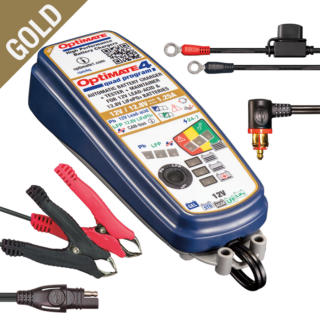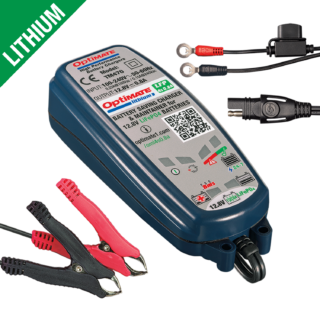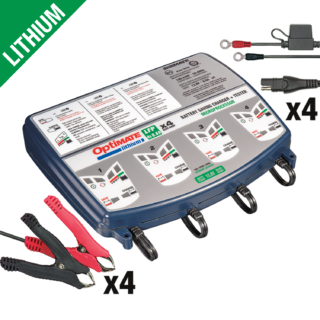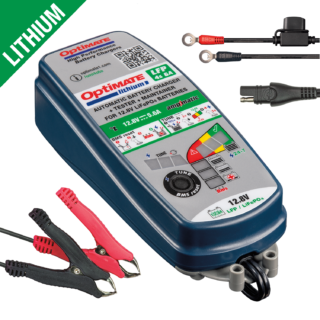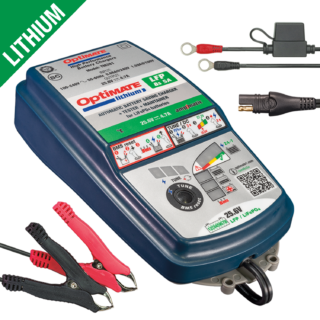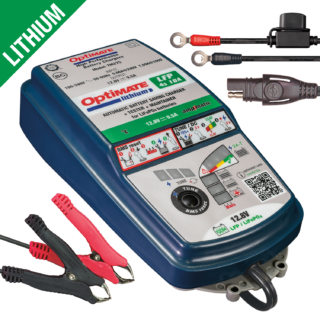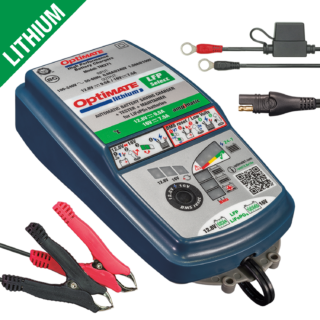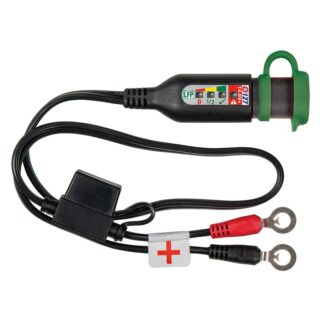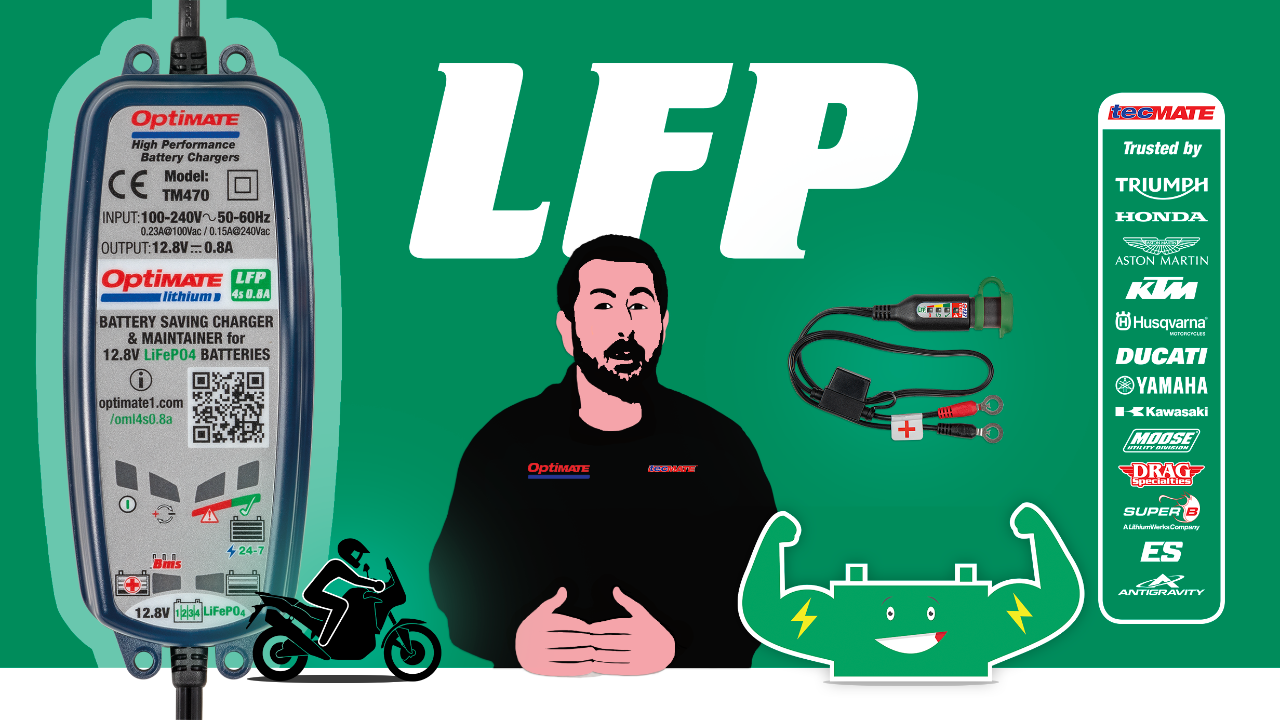Lithium Battery Charger Series

OptiMate has developed a special Lithium battery charger series for vehicles! Why? You can read all about it below. If you want to go to our Lithium battery chargers directly, click here.
Lithium batteries are popular replacements for bulkier and heavier lead-acid batteries. A Lithium battery is lighter, smaller and delivers better engine start performance than the equivalent lead-acid battery.

A 12V lead-acid battery has 6 x 2V cells-in-series, each cell charges up to 2.4V, together the total battery charging voltage is 14.4V. As a result, all 12V vehicle systems are designed to match lead-acid battery technology with normal operating range of 12V to 14.4V.
The matching Li-Ion battery technology on the other hand is Lithium Ferrous Phosphate (LiFePO4 / LFP). A 12.8V LFP battery has 4 x 3.2V cells-in-series. Each cell charges up to 3.6V, together the total battery charging voltage is 14.4V. A 4S (4-cells-in-series) LFP battery has a safe operating range of 12.8V to 14.4V.

When the engine is cranked (turned over) the starter motor draws very high current (measured in Cranking Amps / CA) from the battery. To deliver cranking amps the battery needs to have reserve energy stored that is measured in Amp-hours (Ah). A LFP battery needs less reserve energy (Ah) to deliver the same cranking amps (CA) as a lead-acid battery. To keep cost down, a LFP engine start battery typically has 2-3 times less reserve energy capacity (Ah) than the equivalent lead-acid battery for the same vehicle.

State Of Charge (S.O.C.)
A battery needs a minimum State Of Charge level (S.O.C. %) to deliver its rated cranking Amps, below that level the cranking amps (CA) it can deliver reduces and the engine will struggle to start. Voltage is a good indication of the battery’s State of Charge (S.O.H. %), a lower voltage means less charge / reserve energy remains. A LFP battery works best if its voltage is at 13V (±30% S.O.C) or higher. A sealed AGM lead-acid battery works best from 12.4V (±50% S.O.C.) and higher.

During long term vehicle storage (e.g. over winter) the vehicle’s ‘always on’ electronics slowly uses up the reserve energy (in Amp-hours) of the battery. In the same vehicle, an LFP lithium battery with lower rated reserve energy capacity (Ah rating) discharges faster than a larger lead-acid battery. OptiMate Lithium LFP battery chargers have a special lithium 24-7 SAFE maintenance program that continuously monitors the LFP battery’s voltage and will automatically keep it at a 70% or higher energy level.

State Of Health (S.O.H.)
Lithium LFP batteries can normally receive high charge current when the battery is at 12V or higher, but below 12V it loses the ability to accept high current charge. The further below 12V the less the battery’s ability to accept normal charge. Below 8V it is in a critical State Of Health (S.O.H.) however. At low voltage the LFP battery can only tolerate low current until its voltage is above 12.8V again. An OptiMate Lithium LFP battery charger delivers a SAFE low current recovery charge. It continuously checks cell health as it slowly nurses the lithium LFP battery back towards full health (above 12.8V), when it once again can receive normal charge.

Battery Management System (BMS)
Some lithium-ion batteries have a smart resettable BMS— Battery Management System— to protect it from damage, it shuts down if it senses the battery’s voltage is too low. All OptiMate Lithium LFP chargers therefore have a BMS pulse wake-up system that will reset and reactivate the battery correctly.

Lithium batteries are more expensive than lead-acid batteries. Therefore, to protect your investment use an OptiMate Lithium LFP battery charger. It will guarantee your Lithium LFP battery will last longer and always perform stronger.
LFP Lithium battery chargers
LFP Lithium battery charger FAQ
Yes, motorcycle Lithium batteries are designed to work at the maximum 14.4V charging voltage of any motorcycle. All motorcycle batteries are made from Lithium Ferrous Phosphate technology.
Lithium Ferrous Phosphate cells are scientifically rated at 3.2V nominal. Nominal means the ‘design’ voltage of the cell. A 4-cell-in-series (4s) battery is 3.2V x 4 = 12.8V. How-ever some battery companies prefer to use 3.3V x 4 = 13.2V to show the optimal charge level of the battery; 13.2V is the ±70% State-Of-Charge level.
a) Li-Ion is a generic term for Lithium battery technology. It only identifies the Lithium (Li) part of the chemistry and then how energy is moved inside the battery (Ions move from anode to cathode and vice versa).
b) In motorcycle batteries only Lithium Ferrous Phosphate technology is used, that is shortened to LFP or LiFe (typically seen on Harley Davidson Lithium Ferrous Phosphate batteries).
The manufacturer (Eliiy) of lithium batteries found in Honda motorcycles prefer to use the basic Lithium description of Li-Ion and the voltage that signifies their battery is for a 12V vehicle system. The cells are made from Lithium Ferrous Phosphate, it is a 4-cell-in-series LFP battery that charges up to 3.6V x 4 = 14.4V.
OptiMate Lithium Series:
OptiMate Lithium LFP 4s battery chargers will work with all motorcycle or automotive lithium batteries that are marked Li-Ion 12V, LFP 12.8V, LFP 13.2V, LiFePO4 12.8V and LiFePO4 13.2V.
General lithium LFP FAQ
a) DO NOT JUMP START the battery. It can suffer permanent damage, especially if battery voltage is below 10V. The jump starter dumps very high current into the flat battery that can damage the most discharged cells.
What to do:
b) BEST - Charge the battery with your OptiMate Lithium battery charger until the voltage is above 12.8V (On the OptiMate Lithium charger > Orange SAVE light is off, and yellow CHARGE light is on). Then it has enough energy to start the engine.
Have a check:
Check if your vehicle’s charging system voltage delivers between 14 to 14.4V charge voltage to the lead-acid battery at 2,000rpm or higher. If higher, have your voltage regulator checked or change it out for a Lithium Safe regulator. If you cannot change the charging system (especially on older motorcycles) and it usually runs above 14.4V, rather replace your lead-acid battery with a fully sealed lead-acid AGM battery. Lead-acid batteries can accept some overcharging, but lithium LFP batteries cannot.
Jump starters are made with Li-Ion technology that uses 3.7V cells that charge up to 4.2V. The jump starter is made with 3 cells-in-series > 3 x 3.7V = 11.1V nominal, with max charge voltage of 12.6V. A vehicle system charges up to 14.4V. If charged at 14.4V the jump starter will overheat and spontaneously combust.
LiFePO4
Lithium Ferrous Phosphate (LiFePO4) is the safest Li-ion technology, with a runaway (spontaneous combustion) temperature level of 270°C that rises to 300°C when charged 70% or higher. The lower cell voltage of 3.2V and max charge level of 3.6V allows a 4-cell-in-series battery (4 x 3.6V = 14.4V) to be used in 12V vehicle systems. It is most resistant to overcharging, but it will not tolerate more than 14.6V (3.65V per cell) for very long. If charged above 15V (3.75V per cell) it will overheat.
a) They cannot be charged above 14.6V. If grossly overcharged above 15V they will overheat quickly and may self combust.
b) When flat (below 12V) they are vulnerable to damage, the lower the voltage the more vulnerable they are. They need a slow special charge delivered by an OptiMate Lithium battery charger to recover.
Lithium Li-Ion technologies:
a) The most popular Li-Ion technology is Lithium Cobalt Oxide (LiCoO2) that is used in cell-phones, laptop computers and electric vehicles. The single cell voltage is 3.7V nominal, that can charge up to 4.2V maximum. Thermal runaway = 150°C. It cannot tolerate overcharging.
b) A more expensive, but safer technology is Lithium Manganese Oxide (LiMnO2), with cell voltage of 3.6-3.7V nominal that can charge up to 4.2V maximum. Thermal runaway T = 250°C. It can tolerate mild overcharging.
c) There is a combination Li-Ion technology, Lithium Nickel Cobalt Manganese Oxide (LiniMnCoO2), with cell voltage of 3.7V nominal that can charge up to 4.2V maximum, that is more cost effective than the two above. Used in electric bicycles, medical equipment and portable jump starters. Thermal runaway = 210°C. It cannot tolerate overcharging.

